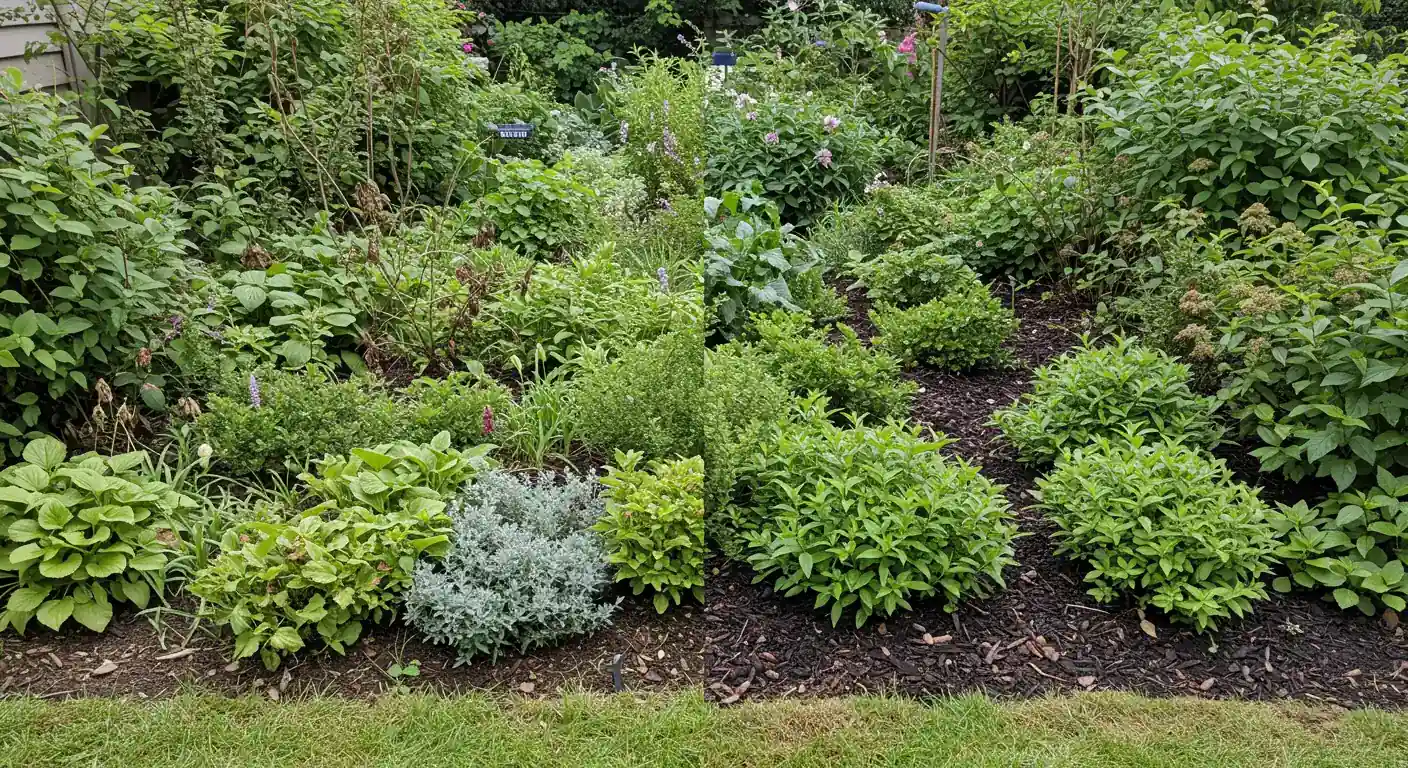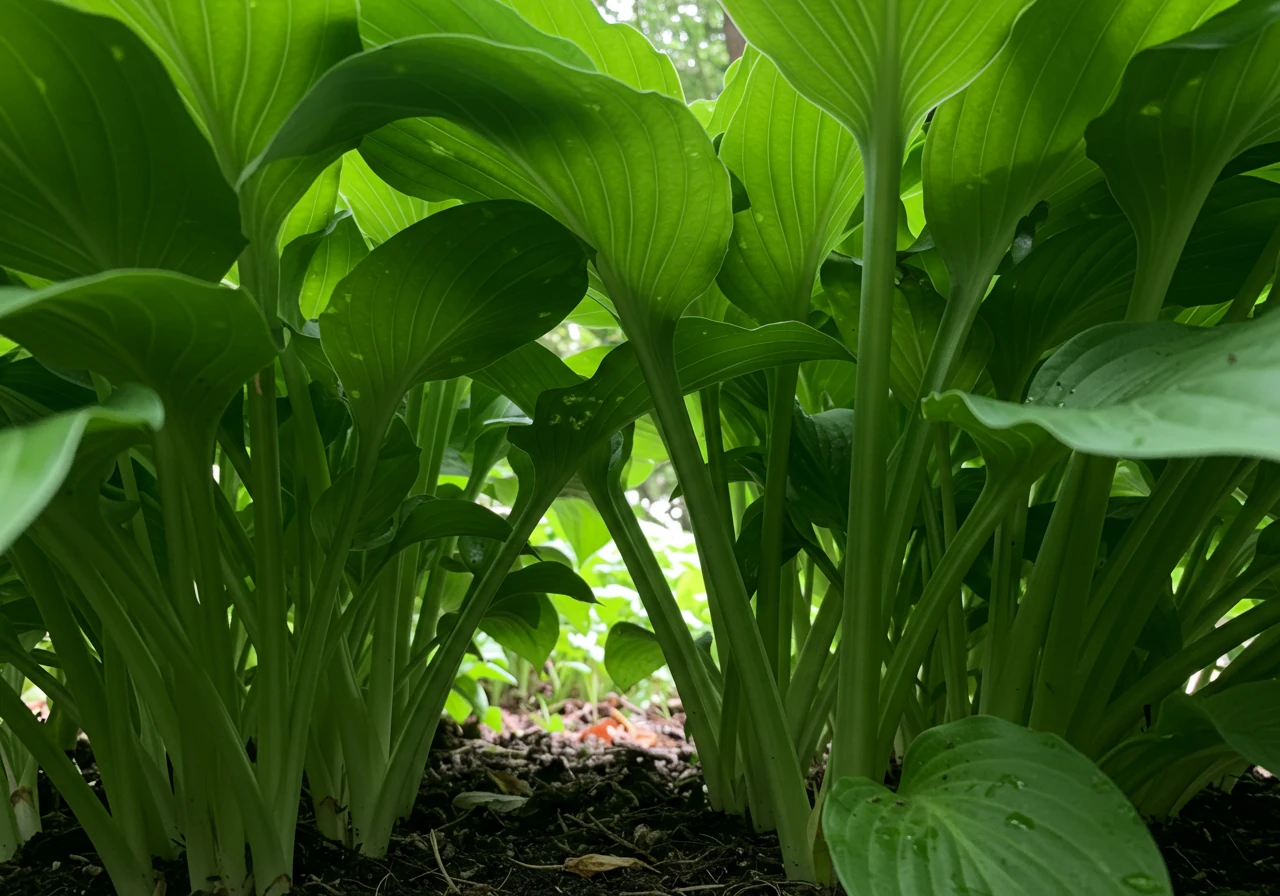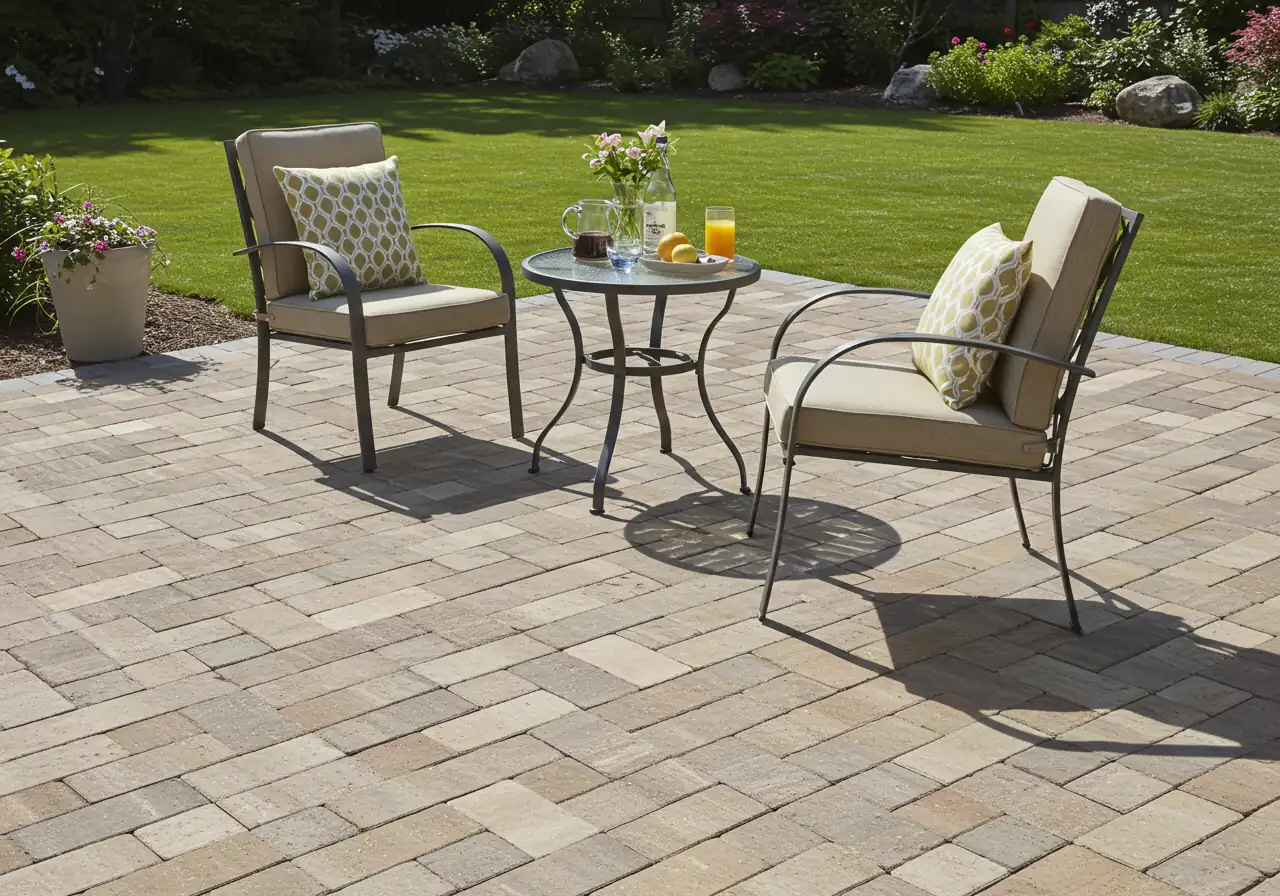Avoid Crowding Richmond: Proper Landscape Element Space
Planning a landscape project in Richmond or the greater Ottawa area? Need help making sure everything fits perfectly? Request a quote today!
Key Takeaways: Proper Landscape Spacing
- Overcrowding plants leads to competition, stress, disease, and poor aesthetics.
- Proper spacing ensures healthier plants, easier maintenance, and better curb appeal.
- Always plan based on the *mature* size of trees, shrubs, and perennials.
- Hardscaping (patios, walkways) needs adequate clearance for movement and function.
- Visualize spacing with stakes or pots before planting.
- Consider Ottawa's climate (snow storage!) and soil conditions.
Introduction: Don't Let Your Yard Feel Like Rush Hour on the 417!

Ever feel like your garden bed resembles rush hour on the 417? Plants jammed together, practically climbing over each other for a sliver of sunlight? While aiming for a lush, full look in your landscaping is understandable, planting things too close together can create major horticultural traffic jams.
When plants are overcrowded, they fiercely compete for essential resources like sunlight, water, and soil nutrients. This intense competition leads to stressed, weaker plants, stunted growth, and poor air circulation – making your garden favourites more susceptible to annoying pests and diseases. It can also make basic gardening tasks like weeding and pruning much more difficult, and frankly, it often just looks cluttered rather than abundant.
The solution is simpler than navigating Ottawa traffic: proper plant spacing! Giving your perennials, shrubs, trees, and even annuals the elbow room they need right from the start is crucial. For homeowners across Ottawa, from Richmond to Barrhaven, understanding spacing helps create a healthy, vibrant, and beautiful yard. It promotes better curb appeal, reduces maintenance headaches, and ensures each plant can reach its full potential. Check out Clean Yards on Google to see how well-planned landscapes look.
In this guide, we'll explore why giving your greenery personal space is so important, offer practical tips for getting the spacing right for different types of plants, and show how planning ahead prevents landscaping logjams down the road. Let's create a garden that breathes! Explore our range of landscaping services to get started.
The 'Why' Behind the Wide Berth: Benefits of Smart Spacing (Especially in Ottawa)
Okay, let's dig into why giving your plants some personal space is one of the smartest moves you can make in your Ottawa garden. Think of it less like enforcing social distancing for your shrubs and more like giving them VIP access to everything they need to thrive. The benefits are huge!

Healthier, Happier Plants are the Goal
When plants aren't crammed together, they don't have to fight like gladiators for sunlight, water, and nutrients in the soil. This is especially key here in Ottawa, where our hot, sometimes humid summers and cold winters already test our greenery. Proper spacing means better air circulation, which significantly cuts down on fungal diseases that love damp, crowded conditions – a common issue, especially if you're dealing with heavier clay soil like you might find in parts of Osgoode. Good airflow helps leaves dry faster after rain or morning dew. Plus, roots get the room they need to spread out and anchor deep, making plants stronger and more resilient. Healthy soil is foundational, learn more about our approach to soil preparation.
Planning for Grown-Up Plants
Those cute little perennials and shrubs you bring home from the nursery? They grow up! Smart spacing means planning for their mature size *now*, so you don't end up with a tangled jungle later where nothing gets enough light. It prevents that overcrowded look where individual plants get lost in the mob. Want to truly see how things will fill in? Considering visualize your mature landscape with Vernon 3D landscape design plans can be a game-changer, letting you see the future growth before you even plant.
Maintenance? Make it Manageable!
Let's be honest, gardening chores are easier when you can actually reach what you need to. Good spacing makes weeding, mulching, and fertilizing less of a back-breaking puzzle. Need to prune? You'll have room to maneuver and make clean cuts, perhaps even using tools that make pruning easier with the right tools without playing Twister around overgrown branches. Winter prep also becomes simpler; accessing irrigation heads for proper Nepean irrigation winterization to avoid pipe damage is a breeze when they aren't buried under foliage. Overall, good spacing just makes seasonal cleanups much simpler, saving you time and effort. You might even need less frequent cleanups like those offered by our Ottawa property cleanup service or Metcalf property cleanup service.
Boosting Beauty and Protecting Property
Properly spaced plants create a balanced, intentional look that significantly boosts your home’s curb appeal. Each plant has its moment to shine! Furthermore, keeping trees and large shrubs appropriately distanced from your house foundation, walkways, and driveways prevents root damage and allows for essential air circulation around your home. It also ensures water flows away from your foundation correctly, complementing work like how good spacing complements proper Richmond spring grading to protect your biggest investment.
Getting the spacing right sets your garden up for long-term success and beauty. If you need a hand planning it all out, check out our comprehensive landscaping services. Our About Us page details our commitment to quality.
Mature Spread Comparison (Example)
Giving Your Greenery Room to Grow: Spacing Trees, Shrubs & Perennials
Okay, so we know why giving your plants breathing room is crucial (healthy plants, easier maintenance, looking sharp!). Now, let's get down to the nitty-gritty: how much space do these green buddies actually need? It’s not quite rocket science, but knowing the basics for trees, shrubs, and perennials will save you headaches later. Think of it as horticultural matchmaking – finding the right spot for long-term happiness!

Trees: Think Big, Plant Smart
Trees are the majestic giants of the landscape, but they start small. Don't let that fool you! The biggest mistake is planting them too close together or too near structures.
- Mature Size is Key: Always, always, *always* check the mature height *and* spread (width) of a tree before planting. Space trees based on their *adult* size. Imagine two mature trees – their canopies should barely touch or have a gap. Large trees (Oaks, Maples) need 20-30 ft apart and 15-20 ft from your house. Smaller ornamentals (Serviceberry) might need 10-15 ft.
- Root Routes: Tree roots spread wide! Keep large trees away from foundations, septic systems (a big consideration in areas like Metcalfe or Kars), driveways, and sidewalks.
- Look Up & Down: Check for overhead power lines and call/click before you dig for underground utilities. Proper spacing simplifies future tasks like Nepean property cleanup service in the fall.
- Specimen vs. Grove: A single ‘specimen’ tree needs visual space. Grove trees can be slightly closer but respect mature spreads.
For tree selection advice, consider our material selection guidance. Reputable sources like the City of Ottawa Tree Planting page offer local insights.
Shrubs: Hedging Your Bets (or Not!)
Shrubs are versatile. Spacing depends on the desired effect.
- Mature Spread Matters: Check the mature width. For dense hedges (Cedars), plant slightly *closer* than mature spread (e.g., 2/3rds width apart, center-to-center).
- Individual Stars: For specimen shrubs, space at or slightly wider than mature spread for natural shape development.
- Foundation Fundamentals: Keep shrubs 2-3 feet off foundations for air circulation and maintenance access. This makes applying mulching and edging easier too.
- Access is Everything: Ensure you can walk between shrubs for weeding/pruning. Proper spacing avoids issues that might require a city garden clean-up service later.
Find inspiration for shrub arrangements in our landscape transformations gallery.
Perennials & Groundcovers: The Spread Offenders
Perennials (Hostas, Daylilies) and groundcovers can spread significantly.
- Read the Tag: Plant tags list mature spread. Space perennials center-to-center based on this width (e.g., 18-inch spread = 18 inches apart). It looks sparse initially but fills in fast!
- Groundcover Goals: For quick fill (Creeping Thyme), plant closer (half to two-thirds spread), but be ready to manage them. Good spacing near lawns complements sod installation areas.
- Future Division: Proper spacing simplifies dividing clumps later. This is a key part of long-term garden maintenance.
- Eco-Friendly Tip: Consider native Ottawa plants (Coneflower, Black-Eyed Susan). They're adapted, support pollinators, and thrive with good spacing. Adhering to best practices, like those outlined in our terms and conditions, ensures quality results.
Learn more about plant choices suitable for our climate from resources like the Master Gardeners of Ottawa-Carleton.
Planning your plant spacing might seem like extra work upfront, but it's the secret to a less crowded, healthier, and more beautiful garden in the long run. It truly benefits the whole yard, integrating well with your overall lawn care strategy by creating defined, manageable spaces. Remember, responsible gardening includes this forward-thinking, just like responsible business includes protecting user information as detailed in our privacy policy. Happy planting!
Hardscaping Harmony: Spacing Patios, Walkways, and Features Wisely
Okay, let's talk about the *other* kind of spacing in your yard – the kind that involves pavers, paths, and places to park your patio chairs! Getting the spacing right for your hardscaping is just as important as giving your plants room to breathe. It’s all about creating flow, function, and avoiding those awkward landscape moments, like having to shimmy sideways past the BBQ.

Hardscaping Harmony: Spacing Patios, Walkways, and Features Wisely
Getting your hardscaping layout right is crucial for a yard that *works* as beautifully as it looks. Think of it less like filling space and more like choreographing movement. Nobody wants a patio that feels like a game of human Tetris or a walkway that doubles as an obstacle course! Proper spacing ensures safety, usability, and harmony between your built elements and your gardening areas.
- Patios & Decks: Room to Relax (and Move!)
- Furniture Fit: Visualize furniture. Aim for at least 3 feet of clear walkway space around groupings.
- Flow is Key: Ensure main traffic routes (door to lawn/grill) are clear and wide (3-4 feet).
- Ottawa Foundations: Proper base prep and slope away from the house are crucial to prevent water/frost issues.
- Walkways: More Than Just a Path
- Width Wonders: Primary walkways (front door) ideally 4-5 feet wide. Secondary paths 3 feet, usable for wheelbarrows.
- Clearance Counts: Keep paths 1-2 feet from foundations. Give bordering plants room to avoid encroachment, simplifying tasks handled during a property clean up.
- Solid Footing: Deep, compacted gravel base (6+ inches) is essential in Ottawa's climate.
- Driveways: The Snow Factor
- Beyond the Car: Factor in width for opening doors.
- Ottawa Snow Duty: CRITICAL! Plan dedicated space *beside* the driveway for snow piles that won't block paths or bury shrubs. This planning complements seasonal readiness, like that provided by an Ottawa property cleanup service.
- Features: Safety and Access First
- Fire Pits: Check local bylaws (like those from the City of Ottawa Open Air Fire Bylaw) for clearances (often 10-25 feet from structures/fences). Ensure ample seating space.
- Sheds & Structures: Allow space for door swing, maintenance access, and airflow. Ensure a stable foundation. Site prep might need a specialized Marionville property cleanup service approach in some areas.
- Lot Size Logic: Adapt spacing to lot size (dense vs. large). Aim for balanced usability. Clearing might need a city yard cleanup service. Our commitment to respecting your property is outlined in our privacy policy.
Well-planned hardscaping integrates seamlessly with your plantings, creating a functional and beautiful outdoor living space. Need inspiration? Take a look at some projects where spacing made all the difference in these inspiring hardscape transformations. Getting the distances right prevents logistical logjams and makes your Ottawa yard a true pleasure to use, potentially reducing the need for frequent visits from a Metcalf yard cleanup service or Marionville yard cleanup service.
Steps to Planning Your Spacing
1. Measure Your Area
Accurately measure the dimensions of your planting bed or yard section. Note sun exposure and existing features.
2. Research Mature Sizes
Check plant tags or reliable sources for the final height and width of every plant you plan to use. This informs material selection.
3. Sketch Your Plan
Draw your area to scale, placing circles representing mature plant spreads. Start with trees and shrubs.
4. Visualize On-Site
Use hoses, paint, or pots in the actual space to represent mature sizes. Walk around and check flow and clearance.
5. Prepare & Plant
Once satisfied, prepare the soil using methods outlined in our soil preparation guide and plant accordingly.
Measure Twice, Plant Once: Planning and Visualizing Your Spaced-Out Oasis

Alright, let's roll up our sleeves and talk planning! You know the old saying, "measure twice, cut once"? Well, in landscaping, it's "measure twice, plant once" – unless you enjoy digging things up again later (we don't recommend it!). A little forethought now saves a *lot* of sweat and potentially avoids that "oops, the spruce ate the walkway" scenario down the road. Creating your beautiful, functional, spaced-out oasis in Ottawa starts with a solid plan.
Here’s a simple approach to get your spacing strategy sorted:
- Know Your Canvas: Grab a measuring tape! Measure the length and width of your garden bed or planting area accurately. Note sun, slope, drainage, and existing features. Is that big maple casting shade? Good to know! Clearing might require a city property cleanup service.
- Future Peeking - Research Mature Sizes: Non-negotiable! Check tags/sources for *mature height and spread*. That cute shrub might need 8 feet later! Guides smart plant and material selection.
- Sketch Your Dream: Use graph paper. Sketch to scale. Draw circles for *mature* spreads (trees/shrubs first), then fill with perennials. Consider sightlines.
- Walk the Space: Crucial! Use hoses, paint, stakes, or pots to mark *mature* footprints outside. Stand back. Check flow. Spot crowding *before* digging. Proper essential soil preparation techniques follow layout finalization.
Visualizing Tip: Place a stake at the plant center. Use a measuring tape set to half the mature diameter and walk a circle. This truly shows the space needed.
Ottawa Seasons in Mind: Plan for year-round interest. Where will snow pile? Will evergreens block winter sun? Proper spacing protects plants from snow load and simplifies seasonal maintenance like a Metcalfe garden clean-up service. Visualize all seasons.
If planning feels overwhelming, especially for larger or complex designs, call the pros! We can help create a cohesive plan. Understanding landscaping estimate feedback helps choose the right partner. See results in our stunning landscape transformations!
Quick Spacing Rules of Thumb
Gardening in Ottawa neighbourhoods like Barrhaven? Avoid plant pile-ups! Here are some quick tips:
- Check the Tag: Seriously, *always* check the plant tag for its mature size – this is your golden rule!
- Trees Need Sky: Space trees based on their adult *canopy* width, keeping large ones at least 15-20 feet from your house.
- Shrub Space: Give shrubs room based on mature width (closer for hedges, wider for showing off). Keep them 2-3 feet off foundations – this simplifies jobs often handled by a dependable city garden maintenance service.
- Walk This Way: Main walkways should be comfy at 4-5 feet wide.
- Patio Comfort: Leave at least 3 feet of clear space around patio furniture for easy movement.
Proper spacing makes future jobs, like a thorough Marionville garden clean-up service, so much easier. Need help clearing the way first? A professional city property cleanup service can prepare your canvas. Even large lots needing a comprehensive Marionville yard cleanup service benefit hugely from smart spacing. Plan well, your future self is sure to say thank you!
FAQs: Tackling Your Ottawa Spacing Conundrums
Got questions about giving your plants the right amount of personal space in your Ottawa yard? You're not alone! Here are some common spacing puzzles solved using our collapsible FAQ format.
Great question! While spacing *distances* don't dramatically change, proper spacing is *extra* important with clay soil. Good airflow between plants helps leaves dry faster, reducing fungal diseases that clay-loving dampness encourages. It also gives roots a better chance to penetrate that dense soil without intense competition right next door.
Small yards require smart choices! Focus on plants with narrower or columnar growth habits. Think vertical gardening or using containers for pops of colour. Carefully plan for mature sizes – every inch counts! When you're ready for planting, a professional new garden bed planting project service can help maximize your small space effectively.
Ah, the eternal Ottawa question! When spacing plants, especially near driveways and walkways, absolutely think about snow storage. Leave ample room beside paved areas for snow piles so you aren't burying or breaking shrubs. Strategic spacing makes snow blowing or shoveling less of a plant-obstacle course and simplifies seasonal prep often handled by an Ottawa fall yard cleanup service.
Using native plants is fantastic for supporting local ecosystems! Treat them like any other plant regarding spacing – research their mature size and give them the room they need to thrive. Some natives spread vigorously! Proper spacing allows them to establish well and simplifies ongoing care, making routine garden care and upkeep much easier down the road. Resources like the Rideau Valley Conservation Authority also promote native plantings.
It happens! Depending on how long they've been there, you might be able to carefully transplant one or two in early spring or fall. If they're established, selective pruning can improve airflow. If it's truly a jungle, sometimes removing the weakest plants is the kindest cut. A city garden bed clearing service can help manage seriously overgrown situations.
Yes, there often are! Bylaws can dictate setbacks from property lines, sidewalks, hydrants, and utilities, especially for trees that will grow large. Planting too close can cause neighbourly disputes or future issues. Always check the latest City of Ottawa guidelines (available on their website) or call 311 *before* planting near boundaries. Keeping these areas tidy is easier with help from an experienced Ottawa garden clean up service.
Conclusion: Give Your Landscape the Gift of Space
So there you have it! Giving your landscape the gift of space isn't just about avoiding a tangled mess that looks like a botanical free-for-all (though that's a nice bonus!). It's the secret sauce for truly happy, healthy plants, much easier gardening chores, and a yard that looks intentionally beautiful, not accidentally cramped. Think of proper spacing as future-proofing your green investments – planning for those perennials, shrubs, and trees to reach their glorious, full-grown potential without wrestling each other for sunlight like contestants on a reality TV show. You'll spend less time fighting overgrown jungles and more time actually enjoying your stunning outdoor space, boosting your curb appeal along the way.
Feeling a bit overwhelmed trying to map out that perfect plant placement or patio layout? Don't sweat it! If you're dreaming up a new design in Ottawa, Manotick, or Russell and want a professional eye to ensure everything fits beautifully now *and* later, reach out to us for a design consultation! We'll help you craft the perfect blueprint for a spacious, thriving yard.
Or perhaps you know what you want, but need help bringing it to life? Whether it's installing new garden beds (see our garden install service), managing existing plants that got a little too friendly, or handling hardscaping with proper clearance, our team provides expert installation and maintenance across Nepean, Winchester, Kars, and surrounding areas. Let us handle the heavy lifting and careful placement, ensuring your landscape thrives. Give your yard the breathing room it deserves – your future self, relaxing in that perfectly spaced oasis, will thank you!

